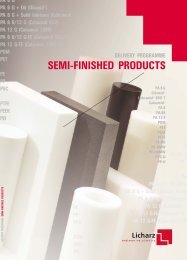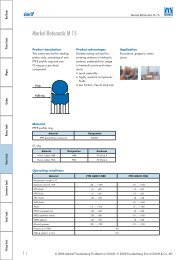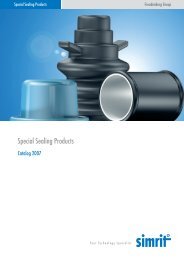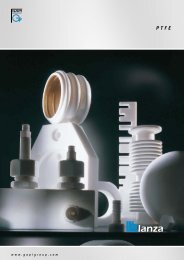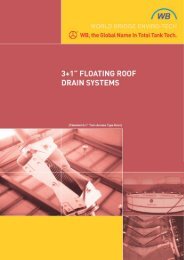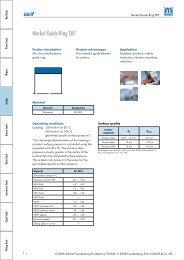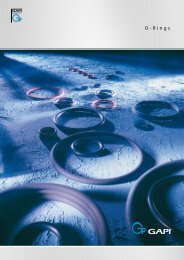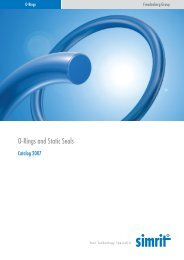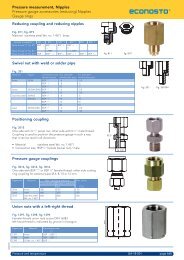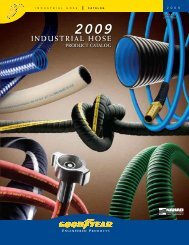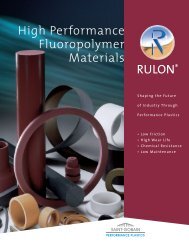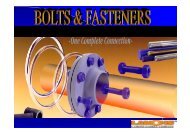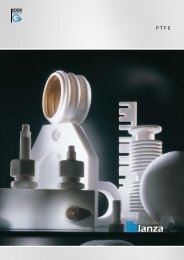Oleodinamica/Pneumatica Hydraulic/ Pneumatic
Oleodinamica/Pneumatica Hydraulic/ Pneumatic
Oleodinamica/Pneumatica Hydraulic/ Pneumatic
Create successful ePaper yourself
Turn your PDF publications into a flip-book with our unique Google optimized e-Paper software.
KDAE<br />
TEnuTA PISTOnE COMPATTA TIPO KDAE<br />
Descrizione<br />
Sempre tra le tenute pistone compatte, la<br />
guarnizione KDAE nasce con un elemento centrale in<br />
poliuretano e due anelli antiestrusione ai lati.<br />
L’assemblaggio combinato del poliuretano ad alto<br />
modulo elastico, con due anelli in elastomero con<br />
elevata durezza, rendono la tenuta molto stabile<br />
anche alle alte pressioni.<br />
Paragonata alla gomma, l’abrasione risulta molto<br />
inferiore con l’utilizzo del poliuretano aumentandone<br />
in questo caso la durata del pistone stesso.<br />
L’attrito di primo distacco ed in esercizio, per<br />
lo speciale profilo geometrico della tenuta, è<br />
maggiormente performante rispetto alla guarnizione<br />
in NBR.<br />
Dati tecnici<br />
Pressione: da 0 a 400 bar<br />
Velocità: < 0,8 m/s<br />
Temperatura: da – 30° C a + 100° C<br />
con punte fino a 110° C<br />
Fluidi: oli a base minerale<br />
(vedi TABELLA I pagg.12-13)<br />
Materiale<br />
I materiali utilizzati per la costruzione di questo tipo<br />
di tenuta sono i seguenti :<br />
- elemento centrale in poliuretano di durezza 93<br />
Shore A Codice materiale tipo C0.<br />
- gli anelli antiestrusione laterali in termoplastico di<br />
durezza 63 Shore D Codice materiale tipo L2<br />
Codice materiale: CR<br />
Montaggio<br />
Il montaggio di questa tenuta può essere eseguito<br />
sia in cava chiusa su pistone monoblocco, sia in cava<br />
aperta su pistone in due pezzi.<br />
E' importante che il pistone non presenti bave<br />
di lavorazione meccanica che andrebbero a<br />
danneggiare la tenuta durante il montaggio.<br />
E' consigliato ingrassare il pistone per facilitare il<br />
montaggio.<br />
<strong>Oleodinamica</strong> & <strong><strong>Pneumatic</strong>a</strong><br />
COMPACT PISTOn SEAL TyPE KDAE<br />
Description<br />
Amongst the compact piston seal series, the KDAE<br />
type is designed with a central polyurethane element<br />
and two side anti-extrusion rings.<br />
The assembly between the polyurethane element<br />
with high elastic modulus and the two elastomer<br />
rings with high hardness enhances stability of the<br />
sealing even at heavy duty applications.<br />
Compared to rubber, the abrasion is also reduced<br />
due to the use of polyurethane, therefore extending<br />
the service life of the seal in the system.<br />
Abrasion is also considerably reduced, thus<br />
facilitating the construction of the seat and bores,<br />
due to the special geometry of the seal itself be ter<br />
performing than NBR.<br />
Technical data<br />
Pressure: from 0 to 400 bar<br />
Speed: < 0.8 m/s<br />
Temperature: from – 30° C to + 100 ° C with peaks<br />
up to + 110° C<br />
Fluids: mineral oils<br />
(see TABLE I, pages 10-11)<br />
Material<br />
The materials used for the construction of this seal<br />
type are as follows:<br />
- polyurethane for the central element, hardness 93<br />
Sh A (C0)<br />
- the backup rings in TPE elastomer 63 Shore D (L2).<br />
Compound reference: CR<br />
Assembly<br />
This seal can be assembled both in closed groove on<br />
a monobloc piston and in open groove on a two-part<br />
piston.<br />
The piston must not have machining scores which<br />
might damage the sealing during the installation.<br />
Recommended to grease the piston to facilitate<br />
mounting.



